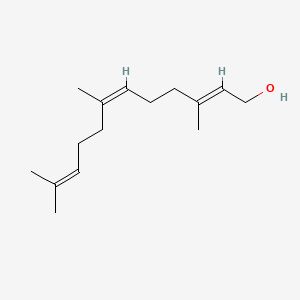| MeSH term | MeSH ID | Detail |
|---|---|---|
| Adenocarcinoma | D000230 | 166 associated lipids |
| Lung Neoplasms | D008175 | 171 associated lipids |
| Body Weight | D001835 | 333 associated lipids |
(e,z)-farnesol
(e,z)-farnesol is a lipid of Prenol Lipids (PR) class.
Cross Reference
There are no associated biomedical information in the current reference collection.
Current reference collection contains 3613 references associated with (e,z)-farnesol in LipidPedia. Due to lack of full text of references or no associated biomedical terms are recognized in our current text-mining method, we cannot extract any biomedical terms related to diseases, pathways, locations, functions, genes, lipids, and animal models from the associated reference collection.
Users can download the reference list at the bottom of this page and read the reference manually to find out biomedical information.
Here are additional resources we collected from PubChem and MeSH for (e,z)-farnesol
Possible diseases from mapped MeSH terms on references
We collected disease MeSH terms mapped to the references associated with (e,z)-farnesol
PubChem Biomolecular Interactions and Pathways
All references with (e,z)-farnesol
Download all related citations| Authors | Title | Published | Journal | PubMed Link |
|---|---|---|---|---|
| Rocha GR et al. | Effect of tt-farnesol and myricetin on in vitro biofilm formed by Streptococcus mutans and Candida albicans. | 2018 | BMC Complement Altern Med | pmid:29444673 |
| Jeon JG et al. | Influences of naturally occurring agents in combination with fluoride on gene expression and structural organization of Streptococcus mutans in biofilms. | 2009 | BMC Microbiol. | pmid:19863808 |
| Cerca N et al. | Confocal laser scanning microscopy analysis of S. epidermidis biofilms exposed to farnesol, vancomycin and rifampicin. | 2012 | BMC Res Notes | pmid:22591918 |
| Langman MJ et al. | Treatment of chronic gastric ulcer with carbenoxolone and gefarnate: a comparative trial. | 1973 | Br Med J | pmid:4577839 |
| Alves FR et al. | Antibiofilm and antibacterial activities of farnesol and xylitol as potential endodontic irrigants. | 2013 | Braz Dent J | pmid:23969910 |
| Alves FR et al. | Biofilm biomass disruption by natural substances with potential for endodontic use. | 2013 Jan-Feb | Braz Oral Res | pmid:23306623 |
| Journe F et al. | Farnesol, a mevalonate pathway intermediate, stimulates MCF-7 breast cancer cell growth through farnesoid-X-receptor-mediated estrogen receptor activation. | 2008 | Breast Cancer Res. Treat. | pmid:17333335 |
| Still K et al. | Effects of risedronate, alendronate, and etidronate on the viability and activity of rat bone marrow stromal cells in vitro. | 2003 | Calcif. Tissue Int. | pmid:12457261 |
| Braun PC | The effect of farnesol on amino acid incorporation by a wild-type and cell-wall variant strain of Candida albicans. | 2005 | Can. J. Microbiol. | pmid:16234870 |
| Tsimberidou AM et al. | Phase 1 first-in-human clinical study of S-trans,trans-farnesylthiosalicylic acid (salirasib) in patients with solid tumors. | 2010 | Cancer Chemother. Pharmacol. | pmid:19484470 |
| Haklai R et al. | Orally administered FTS (salirasib) inhibits human pancreatic tumor growth in nude mice. | 2008 | Cancer Chemother. Pharmacol. | pmid:17909812 |
| Au-Yeung KK et al. | Herbal isoprenols induce apoptosis in human colon cancer cells through transcriptional activation of PPARgamma. | 2008 | Cancer Invest. | pmid:18608213 |
| Joo JH and Jetten AM | Molecular mechanisms involved in farnesol-induced apoptosis. | 2010 | Cancer Lett. | pmid:19520495 |
| Mo H et al. | Farnesyl anthranilate suppresses the growth, in vitro and in vivo, of murine B16 melanomas. | 2000 | Cancer Lett. | pmid:10936674 |
| Yazlovitskaya EM and Melnykovych G | Selective farnesol toxicity and translocation of protein kinase C in neoplastic HeLa-S3K and non-neoplastic CF-3 cells. | 1995 | Cancer Lett. | pmid:7874691 |
| Adany I et al. | Differences in sensitivity to farnesol toxicity between neoplastically- and non-neoplastically-derived cells in culture. | 1994 | Cancer Lett. | pmid:8019976 |
| McAnally JA et al. | Farnesyl-O-acetylhydroquinone and geranyl-O-acetylhydroquinone suppress the proliferation of murine B16 melanoma cells, human prostate and colon adenocarcinoma cells, human lung carcinoma cells, and human leukemia cells. | 2003 | Cancer Lett. | pmid:14643448 |
| Shipman CM et al. | The bisphosphonate incadronate (YM175) causes apoptosis of human myeloma cells in vitro by inhibiting the mevalonate pathway. | 1998 | Cancer Res. | pmid:9850051 |
| Blum R et al. | Gene expression signature of human cancer cell lines treated with the ras inhibitor salirasib (S-farnesylthiosalicylic acid). | 2007 | Cancer Res. | pmid:17409441 |
| Blum R et al. | Ras inhibition in glioblastoma down-regulates hypoxia-inducible factor-1alpha, causing glycolysis shutdown and cell death. | 2005 | Cancer Res. | pmid:15705901 |
